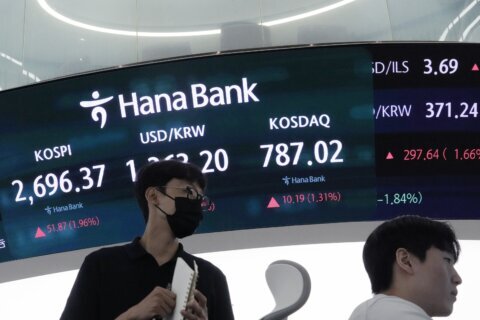WASHINGTON (AP) — The U.S. economy grew at a sluggish 1.3% annual pace from January through March, the weakest quarterly rate since the spring of 2022, the government said Thursday in a downgrade from its previous estimate. Consumer spending rose but at a slower pace than previously thought, a sign that high interest rates and lingering inflation are pressuring household budgets.
The Commerce Department had previously estimated that the nation’s gross domestic product — the total output of goods and services — expanded at a 1.6% rate last quarter.
The first quarter’s GDP growth marked a sharp slowdown from the vigorous 3.4% rate in the final three months of 2023.
But last quarter’s pullback was due mainly to two factors — a surge in imports and a reduction in business inventories — that tend to fluctuate from quarter to quarter. Thursday’s report showed that imports subtracted more than 1 percentage point from last quarter’s growth. A reduction in business inventories took off nearly half a percentage point.
By contrast, consumer spending, which fuels about 70% of economic growth, rose at a 2% annual rate, down from 2.5% in the first estimate and from 3%-plus rates in the previous two quarters. Spending on goods such as appliances and furniture fell at a 1.9% annual pace, the biggest such quarterly drop since 2021.
Still, services spending rose at a healthy 3.9% clip, the most since mid-2021. And an uptick in business investment, led by housing, software and research and development, added more than 1 percentage point to first-quarter annual growth.
A measure of inflation in the January-March GDP report was revised slightly down from the government’s original estimate. But price pressures still picked up in the first quarter. Consumer prices rose at a 3.3% annual pace, up from 1.8% in the fourth quarter of 2023 and the most in a year. Excluding volatile food and energy costs, so-called core inflation rose at a 3.6% clip, up from 2% in each of the previous two quarters.
The U.S. economy — the world’s largest — has shown surprising durability since the Federal Reserve started jacking up interest rates more than two years ago in its drive to tame the worst outbreak of inflation in four decades. The much higher borrowing costs that resulted were expected to trigger a recession. But the economy has kept growing, and employers have kept hiring.
Still, the higher rates appear to be weighing on the economy.
“The impact of the Fed’s tight interest rate policy is clearly visible in the first quarter GDP report,” said Bill Adams, chief economist at Comerica, pointing in particular to a sharp drop in purchases of long-lasting manufactured goods.
A number of signs have suggested that the economy may be weakening. More Americans, for example, are falling behind on their credit card bills. Hiring is slowing, with businesses posting fewer open jobs. More companies, including Target, McDonalds and Burger King, are highlighting price cuts or cheaper deals to try to attract financially squeezed consumers.
And with polls showing that costlier rents, groceries and gasoline are angering voters as the presidential campaign intensifies, Donald Trump has strived to pin the blame on President Joe Biden in a threat to the president’s re-election bid.
The economy’s growth was expected to get a boost from lower interest rates this year. After having lifted its benchmark rate to a two-decade high last year, the Fed had signaled that it planned to cut rates three times in 2024. But the central bank has repeatedly pushed back the start of the rate cuts.
Most Wall Street traders don’t expect the first rate reduction until November, according to the CME FedWatch tool. The rate cuts have been pushed back because inflation, after falling steadily in late 2022 and most of 2023, remains stuck above the Fed’s 2% target level.
“The outlook going forward is uncertain,″ said Rubeela Farooqi, chief U.S. economist at High Frequency Economics. ”A delay in Fed rate cuts to counter sticky inflation could be headwinds for consumption and the growth trajectory over coming quarters.″
Thursday’s report was the second of three government estimates of first-quarter GDP growth. The Commerce Department will issue its first estimate of the current quarter’s economic performance on July 25. A forecasting tool issued by the Federal Reserve Bank of Atlanta suggests that economic growth is on track to accelerate to a 3.5% annual rate from April through June.
Copyright © 2024 The Associated Press. All rights reserved. This material may not be published, broadcast, written or redistributed.






